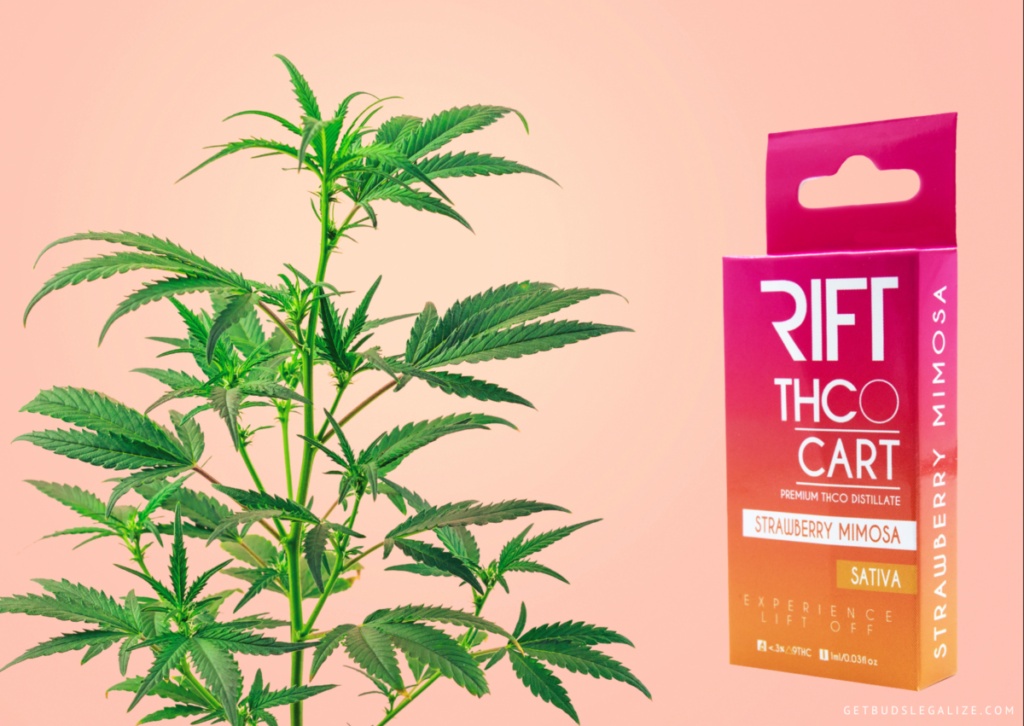What Is THCO? Should I Try It?
If you’re looking for a new way to experience the effects of cannabis, you may have heard of THCO, a synthetic cannabinoid derived from hemp and said to be three times more potent than regular THC.
But what exactly is THCO and how does it differ from other cannabinoids? In this blog post, we’ll explore the history, chemistry, benefits, and harms of THCO, and help you decide if it’s something you want to try.
What is THCO?
THCO, also known as THC-O or THC-O acetate, is an acetylated form of THC that is activated only after being metabolized by the liver. It belongs to a class of substances called prodrugs, which are inactive until converted into active compounds by the body.
THCO is not a natural cannabinoid; is a synthetic compound that is produced by adding acetic anhydride to delta-8 THC or delta-9 THC molecules.
The history of THCO dates back to the 1940s when the US military began studying its effects on dogs as part of their chemical warfare experiments. They found that THCO impaired the dogs’ muscle coordination twice as much as regular THC. However, THCO didn’t enter the illegal market until 1978, when DEA agents discovered a clandestine laboratory in Florida that had synthesized it from cannabis extract.
Since then, THCO acetate has remained a rare and obscure substance until recently, when it re-emerged as a hemp-derived product that can be purchased online.
How is THCO Produced?
THCO is made by converting CBD into delta-8 THC or delta-9 THC and then adding acetic anhydride to the THC molecules. The process involves several stages of extraction, distillation, and chemical reaction which require specialized equipment and skills.
Acetic anhydride is a highly flammable and corrosive substance that can cause severe burns and damage to the eyes, skin, and respiratory system. It is also used in the manufacture of heroin and explosives, making it a controlled substance in some countries.
The quality and safety of THCO products largely depend on the purity and accuracy of the starting materials and the methods used to synthesize them.
What Are the Effects of THC-O?

THCO has effects similar to regular THC, but are more intense and longer lasting. THCO can cause euphoria, relaxation, pain relief, appetite stimulation, creativity enhancement, sensory distortion, time dilation, and altered perception of reality. Some users report experiencing psychedelic effects such as visual hallucinations, synesthesia (mingling of the senses), mystical insights, and spiritual awakenings.
How Strong Is the THCO High?
The psychoactive properties of THCO are significantly more potent and long-lasting than those of THC, the main cannabinoid in cannabis. THCO users often report feeling heightened and altered states of consciousness, similar to those induced by hallucinogens such as LSD or DMT. The duration of the THCO high can range from a few hours to a full day, depending on the amount consumed and the sensitivity of the user.
What Are the Potential Benefits?
There is not much scientific research into the benefits of THC-O, as it is a relatively new and unregulated compound. However, some users claim that THCO can help with pain relief, anxiety, depression, insomnia, appetite stimulation, and creativity.
These effects can be attributed to THCO’s interaction with the endocannabinoid system, which regulates various physiological and psychological functions in the body. However, more studies are needed to confirm the therapeutic potential of THCO.
What Are the Possible Side Effects and Interactions of THC-O?
Some of the possible side effects of THCO are:
- Hallucinations
- Anxiety
- Increased heart rate
- Dizziness
- Paranoia
- Panic attacks
- Psychosis
- Sedation
- Vomiting
- Convulsions
These side effects can be more severe or frequent than those of delta-9 THC, especially at high doses or in combination with other substances. THCO can also interact with medications, supplements, or other cannabinoids and affect their efficacy or safety.
Therefore, it is important to consult a doctor before using THCO, especially if you have any medical conditions or are taking any medications.
How Does Delta-O THC Compare to Other Cannabinoids, such as Delta-8 THC, Delta-9 THC, Delta-10 THC, and HHC?

THC-O compares to other cannabinoids in several ways:
Compared to delta-8 THC, THCO is more potent and has more intense and longer-lasting effects. Delta-8 THC is a naturally occurring cannabinoid found in small amounts in the cannabis plant. Delta-8 THC has effects similar to delta-9 THC, but less strong and with fewer side effects, such as anxiety and paranoia.
Compared to delta-9 THC, THCO has a different chemical structure and acts differently on the endocannabinoid system. Delta-9 THC has relaxing sedative, analgesic, anti-inflammatory, anti-nausea, and appetite-stimulating effects. THC-O has effects similar to delta-9 THC but is more potent and with a longer duration. Some people report that THC-O has almost hallucinogenic or psychedelic effects, while delta-9 THC has more relaxing and sedative effects.
Compared to delta-10 THC, THCO is less stimulating and more sedative. Delta-10 THC is another synthetic cannabinoid that derives from the chemical modification of delta-9 THC. Delta-10 THC has similar effects to Delta-8 THC but is more energizing and focused.
Compared to HHC, THCO is less potent and less psychoactive, with a longer duration of effects. HHC is another synthetic cannabinoid that comes from the chemical modification of delta-9 THC. HHC has a low affinity for the CB1 and CB2 receptors of the endocannabinoid system but has a higher affinity for other receptors such as 5-HT2A, which is involved in psychedelic effects. HHC has effects similar to LSD or psilocybin but with a shorter duration.
How Should I Dose and Consume THC Delta-O Safely and Effectively?
Due to its high potency and delayed onset, THCO can be very dangerous if not used with caution and moderation. If you want to dose and consume THC-O safely and effectively, you should follow these guidelines:
- Start with a very low dose, such as 5mg or less, and wait at least an hour before taking more. Don’t assume you haven’t taken enough if you don’t feel anything right away. THC-O can take longer to kick in than other cannabinoids and can be very strong once it does.
- Use a reliable source of THC-O products that have been tested for purity and potency. Avoid products that may contain unknown contaminants or additives. Check lab reports and product reviews before buying online or from a local supplier.
- Do not mix THC-O with alcohol or other drugs, as this can increase the risk of adverse reactions or interactions. THCO can also affect how your body processes certain medications, so consult your doctor before using it if you have any medical conditions or prescriptions.
- Do not use THC-O if you are pregnant, nursing, or under 21 years of age. THCO can have adverse effects on your health or your baby’s health. It can also impair brain development or cognitive function if you are young.
- Do not use THC-O if you have a history of mental health problems, such as anxiety, depression, psychosis, or schizophrenia. THCO can worsen symptoms or trigger a psychotic episode. It can also cause paranoia, hallucinations, or delusions in some people.
- Do not use THC-O if you have a history of heart problems, such as high blood pressure, arrhythmia, or angina. THC-O can increase heart rate and blood pressure, which can lead to a heart attack or stroke. It can also cause chest pain or heart palpitations in some people.
- Do not use THC-O if you have to drive, operate machinery or perform activities that require alertness or coordination. THCO can impair judgment, reaction time, and motor skills. It can also cause drowsiness, confusion, or dizziness in some people.
Another thing to consider when dosing THC-O is the method of consumption used. THC-O can be consumed in a variety of ways, such as vaping, smoking, dabbing, or ingesting. However, not all methods are equally effective or safe.
- Vaping or smoking THC-O may provide a faster onset of effects, but may also increase the risk of lung damage or irritation from the high temperatures involved.
- Dabbing THC-O can produce even stronger effects than vaping or smoking, but it can also be very dangerous if done improperly or with contaminated products.
- Ingesting THC-O may be the safest and most convenient way to consume it, but it can also result in the most delayed and unpredictable effects due to liver metabolism.
Is THCO Legal?

The legal status of THC-O is unclear and can vary by state or country. Some manufacturers argue that THC-O is legal because it comes from hemp, which is federally legal under the 2018 Farm Bill.
However, this argument may not hold up in court because THC-O is not a naturally occurring cannabinoid in hemp and falls under the definition of a synthetic analog of THC. Synthetic analogs of THC are illegal under the Controlled Substances Act and could be prosecuted by the DEA.
Additionally, some states have already banned or restricted THC-O along with other hemp-derived cannabinoids such as delta-8 and delta-10 THC. These states include Alaska, Arizona, Arkansas, Colorado, Delaware, Idaho, Iowa, Kentucky, Mississippi, Montana, New York, North Dakota, Rhode Island, Utah, and Vermont. Therefore, before buying or consuming THC-O-based products, it is advisable to check local laws and consult an experienced lawyer on the subject.
Bottom Line - Should I Try It?
THC-O is a new and powerful cannabinoid that may offer some benefits for recreational or medical users who are looking for a strong, long-lasting high. However, it also carries many risks and uncertainties that should not be ignored or underestimated. If you decide to try THC-O, be sure to do your research, use it responsibly, and listen to your body.
THCO - FAQs
THC-O is a synthetic cannabinoid that is derived from hemp and is much more potent than regular THC. It can cause psychoactive effects and feelings of euphoria, but also some unpleasant side effects such as anxiety and paranoia.
Some of the side effects of THC-O include:
- Anxiety, paranoia, and psychosis.
- Increased heart rate and blood pressure.
- Impaired memory and cognition.
- Drowsiness and sedation.
- Nausea and vomiting.
- Dry mouth and red eyes.
- Allergic reactions and skin irritation.
THC-O is not regulated or tested for safety or purity, so it may contain harmful contaminants or additives. It may also interact with other medications or substances, causing unpredictable and dangerous effects. THC-O may be addictive and cause dependence and withdrawal symptoms.
THC-O and CBD are two different compounds derived from the cannabis plant. THC-O is a synthetic analog of THC, the main psychoactive component of cannabis, while CBD is a natural cannabinoid that has no intoxicating effects.
THC-O is more potent than THC and may have different medical and recreational effects. CBD is widely used for its anti-inflammatory, anti-anxiety, and neuroprotective properties.
Both THC-O and CBD are legal in some states and countries, but not in others, so it is important to check the local laws before using them.
THC-O may show up on a drug test as THC or another cannabinoid, depending on the type of test and the sensitivity of the device. Therefore, if you use THC-O, you may fail a drug test for cannabis or other substances.
Hemp Derived THC is a term that refers to the tetrahydrocannabinol (THC) content of hemp plants. Hemp is a variety of cannabis that has low levels of THC, the psychoactive compound that causes a high. Hemp Derived THC means that the THC in a product comes from hemp plants, not from marijuana plants that have higher levels of THC.
Synthetic cannabinoids are a class of *designer drug molecules* that bind to the same receptors as the natural cannabinoids found in cannabis plants, such as THC and CBD. These substances are not derived from cannabis plants but are created in laboratories and sprayed on dried plant material or sold as liquids to be smoked or vaporized.
Synthetic cannabinoids are often marketed as herbal incense, herbal smoking blends, or synthetic marijuana, and labeled as “not for human consumption” to avoid legal restrictions. However, these labels are misleading and dangerous, as synthetic cannabinoids can have unpredictable and harmful effects on the brain and body.
THC-O is a synthetic compound derived from hemp that is much more potent and psychedelic than regular THC. THC-O stands for THC-O acetate, which is made by adding acetic anhydride to delta-8 THC.
THC-O is not well-studied and its safety and side effects are unknown. It may have some therapeutic potential, but it also carries a high risk of overdose, anxiety, paranoia, and other negative reactions.
The optimal dose of THC-O depends on several factors, such as the individual’s body weight, tolerance, metabolism, and desired effects. However, as a general guideline, it is recommended to start with a low dose of 2 to 5 mg and wait at least 90 minutes before taking more. Higher doses of THC-O may cause unpleasant side effects such as anxiety, paranoia, nausea, and increased heart rate.
According to some sources, it can take 30 minutes or more for the effects of THC-O to be felt after ingestion. This is because THC-O is a pro-drug that needs to be metabolized by the body before it becomes active. The duration and intensity of the effects may vary depending on the dose, method of administration, and individual factors.

















